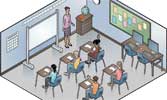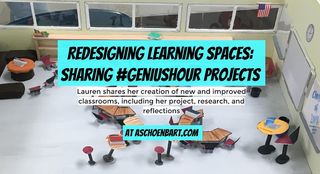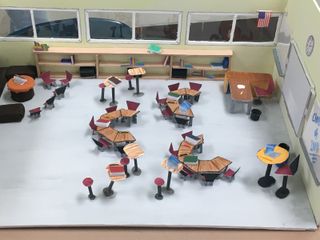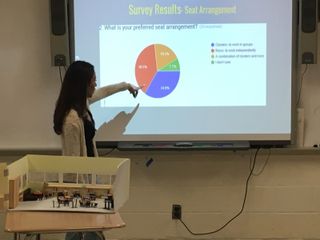Redesigning Learning Spaces: Sharing #GeniusHour Projects


Anytime I think that my students have produced something interesting, I want to share it. Whenever I do something interesting in my teaching or professional development--success or failure, I want to share that, too. I love learning from and sharing our successes and challenges with an authentic audience with the hopes of connecting, inspiring, and sharing our awesome.
And this is one of the successes.
Last year, I shared my students’ #20Time work in a series called 1st Time #20Time, which culminated withSharing Student Projects. Our projects wrap up this week with the last few presentations, and I plan to share those, along with reflections from me and my students soon.
At least one project really stood and was worth sharing on its own, though, as an example of what I think passion-based learning could produce. Early on, Lauren decided she wanted to study classroom spaces, wondering about the impact that architecture and design had on students. Her topic excited me, and I shared my experiences at the Corbett Experience Center (see Rethinking Learning Spaces at #EDnado) and connected her with teachers like Jimmy Sapia.
Lauren researched the topic, interviewed experts, conducted her own survey, and redesigned the classroom. She built a model of her ideas classroom and presented careful, thoughtful, and research-based arguments for every single decision. Next, I want to give Lauren my classroom to turn her ideas into reality.
The rest of this post is all Lauren. I asked her if I could share her reflections on her work, and she even wrote some additional thoughts on her process. Check out Lauren’s blog and her presentation, New and Improved Classrooms for more detail. Below, find a clip I filmed from her in class presentation.
Find more of my recent writing on Genius Hour check out Sharing Students’ Genius: A #GeniusHour Reflection, Developing Genius: Reflecting on Choice, Passion, and #GeniusHour, Teaching Students to Conduct Action Research, and My Questions About #GeniusHour. For my students’ blogs and work, visit geniushour.aschoenbart.com.
Tech & Learning Newsletter
Tools and ideas to transform education. Sign up below.
New and Improved Classrooms
By Lauren Herran
Genius Hour was a way for me to explore my passion for architecture. To start my journey of research, I first had to come up with a question. Coming up with my question wasn’t easy, however, what helped me was to connect something that I love and a current problem that affects me and others. I’m interested in architecture and uncomfortable in my classrooms, so I decided to ask: “How can the design of classrooms be changed to accommodate student’s comfort and learning?”
Before starting any research I first had to think about my purpose and who my audience was because this leads to a better understanding of what kind of goals you would want to achieve. Setting up a blog was my next step. My blog would allow anyone to see my thoughts and process. A teacher from Texas even commented on my blog saying that they were in the middle of redoing their school and that she was interested in seeing what I find out through my research. In a way, this motivated me to continue with my research.
The best way to display my learning was to make a visual representation of a model classroom. My research, interview, and survey had to be included in the making of the ideal classroom. I used articles for research and I learned about factors that influence students such as light, temperature, color and seat arrangement. It was recommended to use as much natural light possible, so I knew I had to include big windows in my classroom.

In my research I learned that colors have a connection with the mood and attitude of a student and teacher, such as green and blue having a calming effect and colors such as yellow and orange having a stimulating effect. So, for my ideal model a yellow tone wall color would make students feel more awake. For seating arrangements, I learned that rows work best for working individually and clusters are perfect for engagement with students.
Knowing that every student works differently, I used a combination of seating arrangements in my model. Although I did learned a lot from my research, I still needed information from someone who has experience with my topic. I ended up getting help from my teacher, who went on Twitter and found a teacher from Connecticut who was an expert on learning spaces. In my interview, I learned that standing desks are great for students who have more energy and prefer not to sit. Ideapaint plays a part in my classroom design, which is white board paint that students can use to show their work on using Expo Markers. Couches or a small living room space are also an ideal place for students to sit when working in group or they just want to feel comfortable when reading books.
My interview led me to create standing desks, a couch and coffee table in a corner and a wall that is painted by Ideapaint. My project was almost done, and the only thing I was missing was Ossining students’ voices. Students should be part of the design process because I am creating a classroom that can be used in Ossining High School. Creating a survey allowed me to get direct responses from many students.

The main thing I noticed was that almost everyone hated their classroom for being old and dull, which has a negative effect not just on their attitude but their teachers' teaching as well. Many students also hated their desks because since the chairs and desks were connected they couldn’t adjust it to their liking. I then made sure to make my model classroom look spacious and modern. After putting together my research, interview and survey I was able to create an ideal classroom for students and teachers to feel comfortable.
My project was a success because I did accomplish my goal which was to create a visual model of an ideal classroom. I put a lot of effort and time in building every single detail and making sure to explain its purpose. My project included many important factors such as color, lighting, seat arrangements, and organization.
Genius Hour helped me to become a better researcher, and now I have experienced conducting an interview with an expert. I wrote an annotated bibliography. I gained new knowledge on learning spaces. Due to the final product that I created, I have improved as a future architect. With these skills and knowledge, Genius Hour is something that will help me in the future.
More #GeniusHour Products
Thank you, Lauren.
Everything above since I introduced Lauren was her writing and reflection. I hope to have more students share their reflections and work, both individually and as a class, in the near future. Until then, you can go to http://geniushour.aschoenbart.com for more examples of our #GeniusHour process and products.
What are your favorite #GeniusHour projects? What are some of the challenges of helping students succeed with passion-based learning?
cross posted at www.aschoenbart.com
Adam Schoenbart is a high school English teacher, Google Education Trainer, and EdD candidate in Educational Leadership. He teaches grades 10-12 in a 1:1 Chromebook classroom at Ossining High School in Westchester County, NY and received the 2014 LHRIC Teacher Pioneer Award for innovative uses of technology that change teaching and learning. Read more at The SchoenBlog and connect on Twitter @MrSchoenbart.
